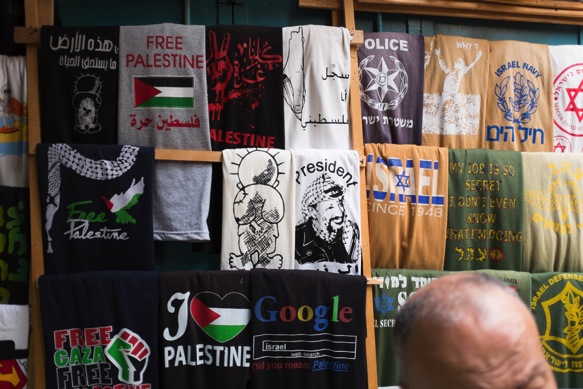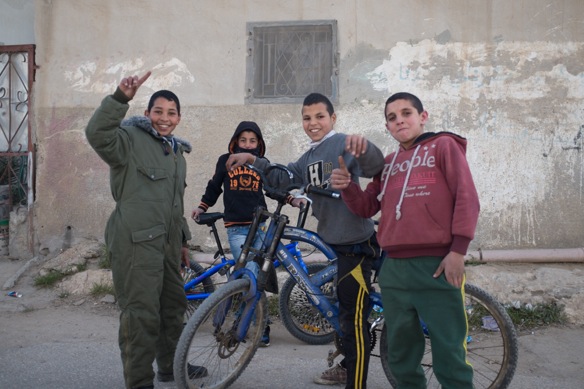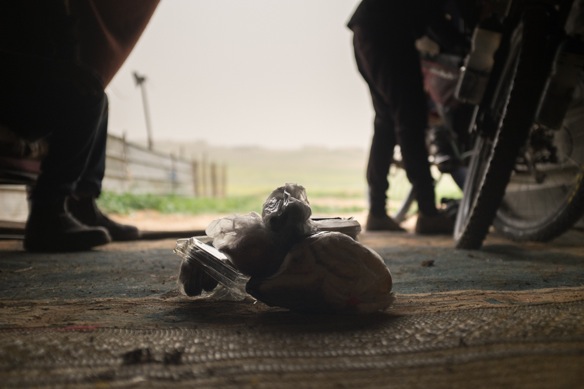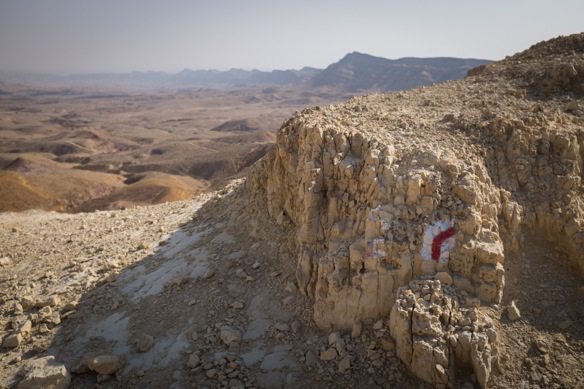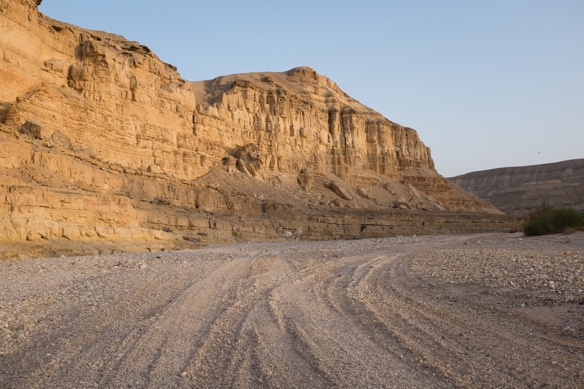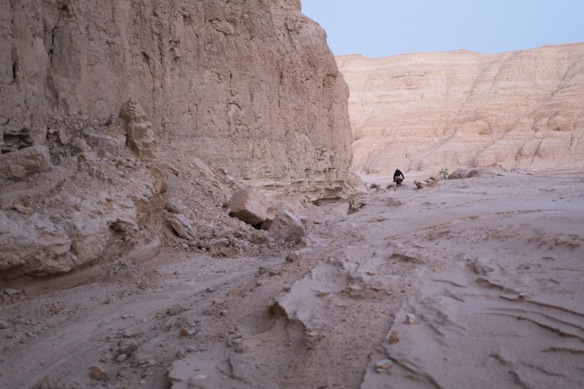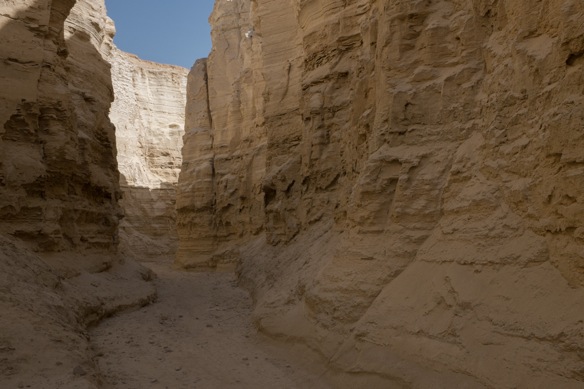
Journey to Jerusalem between solar powered weeks in the Negev and the rising tide of spring in the rest of Israel, unfolding new layers of riding to the north. Arriving in Eilat on the first of February, we cordone ourselves to the south for a few weeks, making circles in the desert to join Ilan and Danny for a fresh piece of the IBT. We finally pass north to the Dead Sea, and out of the deepest natural basin on Earth, in a sandstorm. We continue toward the north– just to the center of the country– to Jerusalem and Tel Aviv. Jerusalem: an ancient modern city amidst a series of steep hills, bounded on three sides by Palestine, one of the highest densities of religious Jews in the country, rich in culture and beauty and diversity. Tel Aviv, I now know, is quite the opposite.
Rain arrives in tandem with our arrival to Jerusalem, 2500ft above sea level. Cold weather sees us into a cave for the night, one of hundreds or thousands in these limestone hills. But this cave just happened to find us on a dark night on a terrace just below the HLC route, just out of town (GPS coordinates here). We push onto a narrow track to set up our tent in the pines. A dark hole in the yellow glow of the evening catches Lael’s attention– just a mile from the edge of the city, properly– we literally walk into a warm dry cave out of the rain. This becomes our home for the two and half days in Jerusalem. This place, we promise, remains on the list of places to revisit.
On our first morning in the city, we meet Louis in the souk. Dates and nuts and Euro-chocolate pastries take center stage, next to olives and piles of pita and fruits and vegetables. It is a nice market, probably stunning if you come from Iowa, but nothing compared to Cairo. Cairo tends not to be a popular topic of discussion in Israel; instead, I tell people we have come from Eilat. That’s nice.
Louis comes from Iowa. He first traveled to Israel at the age of 18. Ten years later he has just completed six months of mandatory military service, now awaiting his Israeli passport in the post. He will maintain dual citizenship, but plans to live in Israel. He finished with the military last week, and begins work as a music teacher on Tuesday. After a cold shower and several cups of hot coffee, we walk all around the city to the tune of every thread of information our impromptu tour guide can offer. His knowledge and passion for the city is contagious, passing secret alleyways and favorite eateries. He rides a Brompton and without hesitation, asks us to coffee at his apartment as soon as we meet. Thanks Louis!
We meet Julian on our second evening in town. Julian comes from Philadelphia by way of a semester in Jerusalem a few years ago through Eastern Mennonite University. He came back to volunteer time to develop the Jesus Trail. He now works for the Abraham Path, an international walking path projected (and growing) across the Middle East, from Sinai to Turkey. Through the development of local walking resources, the organization aims to empower governments and people to welcome visitors, and in return, to hit the trail to discover other parts of the Middle East. This is grassroots diplomacy, although the organization claims to be “non-profit, non-religious, and non-political”. Most staff members come from the USA and the EU. The Abraham Path relies on the vast network of existing trails in Israel, yet charts a new path through the West Bank (Palestine) The Jordan Trail is now complete. A projected route is in development in Sinai. Scouting trips have been made to Eastern Turkey. Syria is on hold for the moment. There is talk about extending the path into Iraq. Julian has been a valuable resource to us, even before we set foot in the country. He has suggested routes and contacts in Israel, and proposes a trip to Jordan later in the month. He rides a secondhand Surly Pugsley. Thanks Julian!
Yuval stands outside staring at our bikes, locked under the sodium glow of a street lamp. We exit the coffee shop with Julian, a stack of 1:50,000 hiking maps in his hand. Yuval is in awe of our bikes, “they are beautiful” he repeats over and over. Immediately, he offers a place to stay for the night. He invites us to the small bar where he works, for a round of Goldstar lagers. We talk until late in the night about bikes and travel and Jerusalem. He has recently completed his three year military service and has begun to study animation at Bezalel Academy. He rides a finely appointed Surly Long Haul Trucker which he acquired in Germany and has taken to Iceland. There, he ran into a guy that wrote a story for Bunyan Velo. “You know Bunyan Velo?” he asks.
Yuval asks if we know Poppi, aka @UltraRomance. I don’t, but I point the question at Lael, knowingly. You know a guy named Benedict? “You mean Jeremy’s buddy from Texas?” We’ve both heard that name while camping with Jeremy.
“I drew a picture for him.”, Yuval says simply. “He said he would send a patch.”
He never sent a patch, despite the massive popularity of Yuval’s pencil work, including a recent feature on The Radavist.
I’ve been carrying a Bunyan Velo patch in my wallet for the last eight months. As I pass it to Yuval, he reaches for an envelope from Matt Whitehead, Patagonia-sponsored traveler, fatbike rider, and surfer. The envelope contains a small stack of patches, a white background with a line drawing of a bicycle and a bundle tied off the back. The bundle is a heart. He hands one patch to me, and another to Lael. Thanks Yuval!
Bike, electric bikes, and pedestrians; signs warning not to enter religious Jewish communities dressed in pink shorts and cutoff sleeves; an Ethiopian Orthodox church, lions everywhere in there; the Old City, the Church of the Holy Sepulchre, the Western Wall, and a big line to visit the Temple Mount, normally closed to nonbelievers; hummus, dried fruits, sweets; Russian, Hebrew, Arabic, lots of English; vineyards and INT singletrack and farm tracks and a dirt road entrance all the way into Jerusalem; a mosaic showing Jerusalem at the center of the world; Louis, Julian, and Yuval; an IMBA certified trail out of town and a signed route to Tel Aviv; and of course, our cave.

























